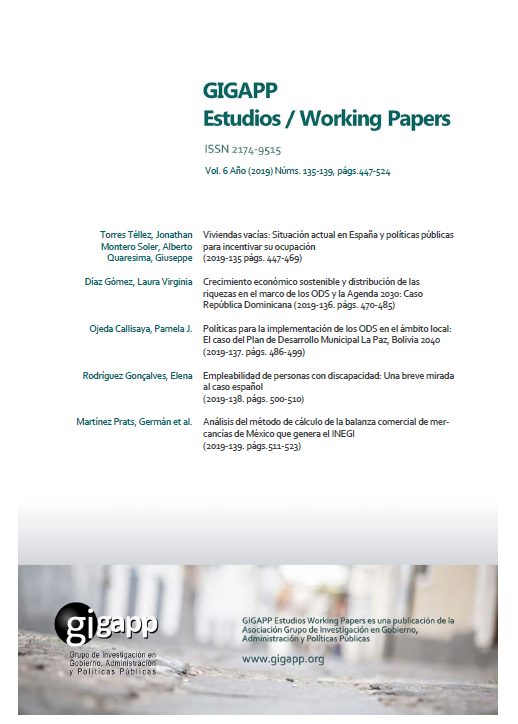Políticas para la implementación de los ODS en el ámbito local: El caso del Plan de Desarrollo Municipal La Paz, Bolivia 2040
Resumen
La mayoría de los temas abordados en los ODS no son nuevos para los gobiernos locales, pues en muchos sentidos están directamente relacionados con sus mandatos. El Gobierno Autónomo Municipal de La Paz, Bolivia, ha elaborado el Plan Integral “La Paz 2040: La Paz que queremos”, aprobado mediante Ley Municipal Autonómica No. 068 del 18 de marzo del 2014, el cual consolida el desarrollo económico-social con el uso y ocupación del territorio. Se concluye en este trabajo en progreso que la puesta en práctica de los ODS requiere bajo este contexto, un enfoque integrador que permita explorar nuevas estrategias y formas de relacionamiento entre los niveles de gobierno como se desarrolla en La Paz, Bolivia. También que es importante que los gobiernos en todos sus niveles ordenen, integren y destinen una parte de sus presupuestos al desarrollo de políticas, programas o proyectos con la Agenda 2030, en un marco de participación y control de recursos.
Descargas
Citas
Arellano, David, José Sánchez y Bartolo Renata 2014: ¿Uno o varios tipos de gobernanza? Más allá de la gobernanza como moda: la prueba del tránsito organizacional. Cuadernos de Gobierno y Administración Pública, México.
Arenilla, Manuel. 2018. La oportunidad de los ODS para reformar la agenda pública iberoamericana, Conferencia realizada en el marco del Programa Académico Regional 2017-2018 de la Escuela Iberoamericana de Administración y Políticas Públicas (EIAPP) del CLAD.
Bardach, Eugene “Los ocho pasos para el análisis de políticas públicas – Un manual para la práctica”, Centro de Investigación y docencia económica, México, 2001.
Constitución Política del Estado Plurinacional de Bolivia, 2009.
Ley Marco de Autonomías y Descentralización “Andrés Ibañez”, Ley No. 031 de 19 de julio de 2010.
Ley de Gobiernos Autónomos Municipales, Ley No.482 de 09 de enero de 2014.
Ley 475 de “Prestaciones de Servicios de Salud Integral del Estado Plurinacional de Bolivia” de 30 de diciembre de 2013.
Gobierno Autónomo Municipal de La Paz, Ley Municipal Autonómica GAMLP No.068 de 04 de abril de 2014..
Programa de las Naciones Unidas para el Desarrollo, “Metodologías del programa ART PNUD aplicadas en Bolivia”, PNUD, 2016.
Sánchez Gutiérrez, Arturo “El proceso de diagnóstico en la elaboración de políticas públicas”, Perfiles Latinoamericanos: revista de la Facultada Latinoamericana de Ciencias Sociales, México, 1993.
Derechos de autor 2019 Pamela J. Ojeda Callisaya (Autor/a)

Esta obra está bajo licencia internacional Creative Commons Reconocimiento-NoComercial-CompartirIgual 4.0.
Aquellos autores/as que tengan publicaciones con esta revista, aceptan los términos siguientes:
a. Los autores/as conservarán sus derechos de autor y garantizarán a la revista el derecho de primera publicación de su obra, el cuál estará simultáneamente sujeto a la Licencia de reconocimiento de Creative Commons Attribution-NonCommercial-ShareAlike 4.0 International (CC BY-NC-SA 4.0) que permite a terceros compartir la obra siempre que se indique su autor y su primera publicación esta revista.
Con esta licencia de acceso abierto, los lectores (usuarios) pueden:
- Compartir — copiar y redistribuir el material en cualquier medio o formato
- Adaptar — remezclar, transformar y construir a partir del material
Bajo los siguientes términos:
-
Atribución — usarios deberán dar crédito de manera adecuada, brindar un enlace a la licencia, e indicar si se han realizado cambios. Puede hacerlo en cualquier forma razonable, pero no de forma tal que sugiera que usted o su uso tienen el apoyo de la licenciante.
-
NoComercial — usuarios no puede hacer uso del material con propósitos comerciales.
-
CompartirIgual — Si remezcla, transforma o crea a partir del material, usuarios deben distribuir su contribución bajo la misma licencia del original.
-
Sin restricciones adicionales: los usuarios no pueden aplicar términos legales o medidas tecnológicas que restrinjan legalmente a otros de hacer cualquier cosa que permita la licencia.
b. Los autores/as podrán adoptar otros acuerdos de licencia no exclusiva de distribución de la versión de la obra publicada (p. ej.: depositarla en un archivo telemático institucional o publicarla en un volumen monográfico) siempre que se indique la publicación inicial en esta revista
c. Se permite y recomienda a los autores/as difundir su obra a través de Internet (p. ej.: en archivos telemáticos institucionales o en su página web) antes y durante el proceso de envío, lo cual puede producir intercambios interesantes y aumentar las citas de la obra publicada. (Véase El efecto del acceso abierto).



